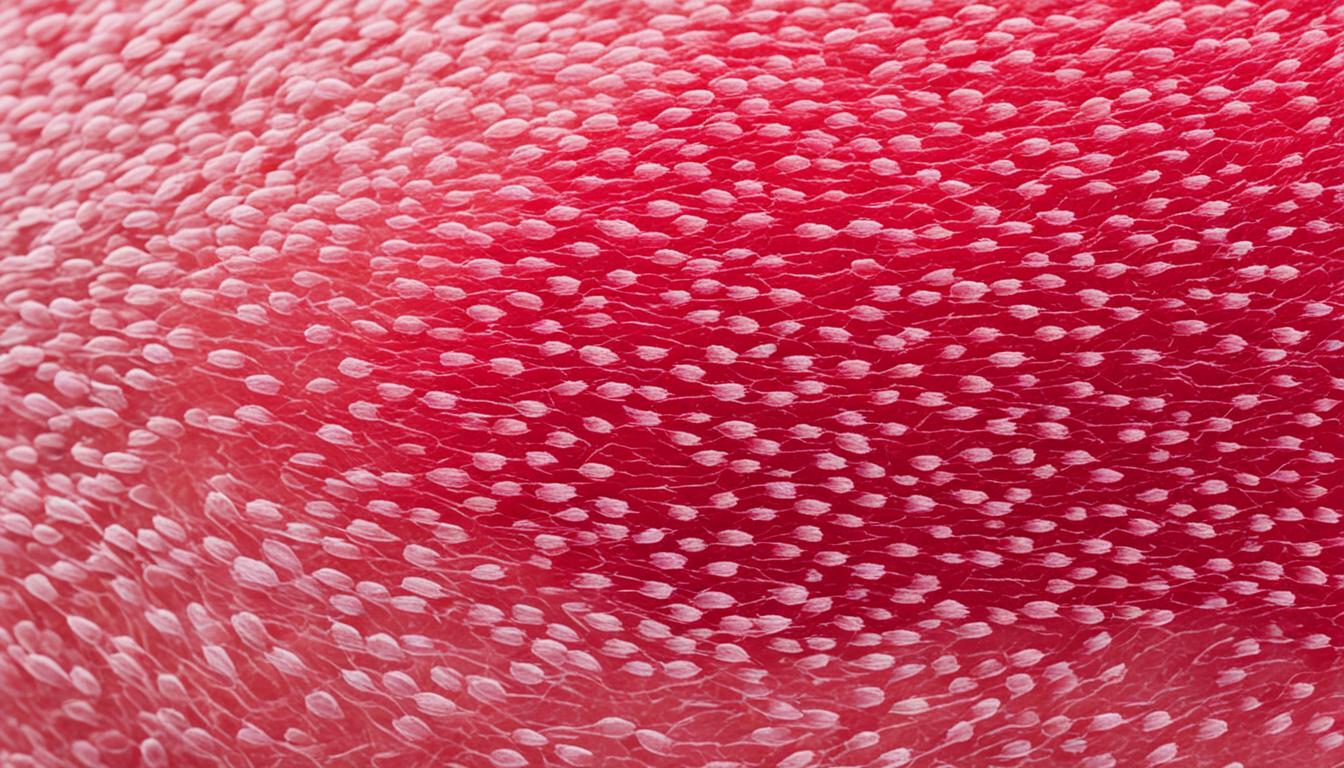Folliculitis is a skin issue where hair follicles get inflamed. An infection of the follicle often causes it. This leads to pimple-like spots, especially when irritations occur. These irritations can come from bad shaving, tight clothes, scrubbing, or some drugs. Folliculitis shows itself with small bumps that are discolored and have a pus tip. It can make you itch, have sore spots, pus-filled sores, red and swollen skin, and it might hurt.
Most times, folliculitis goes away without a fuss. But if it sticks around or gets worse, you should see a doctor. They can suggest treatment like skin creams or pills, or even light therapy. Lately, stem cell therapy is offering hope for better, lasting results against folliculitis.
Key Takeaways:
- Folliculitis is a skin disorder characterized by inflammation of hair follicles.
- The most common cause of folliculitis is damage to the hair follicle.
- Symptoms of folliculitis include small discolored bumps with a white, pus-filled tip, itching, tender bumps, pus-filled sores, inflamed skin, and pain.
- Treatment options for folliculitis include medication, light therapy, and stem cell therapy.
- If symptoms persist or worsen, it is recommended to consult a healthcare professional.
Causes of folliculitis
Folliculitis is a common skin issue with many causes. Knowing these helps treat and prevent it from coming back.
Staphylococcus aureus bacteria is the main culprit. It infects the hair follicles, causing swelling and pain. Yeast, fungus, and viruses can also lead to folliculitis.
Several things can irritate the skin and lead to this condition. These include clogging the hair follicles, using steroids, certain skin illnesses, some medicines, and harsh chemicals. They weaken the follicles’ defenses, making them prone to infection.
Several risk factors make getting folliculitis more likely. If you have diabetes, use a lot of antibiotics, shave often, swim in dirty water, have a weak immune system, or are overweight, you’re more at risk. These things make your skin less able to fight off infections.
Treat and prevent folliculitis by finding and fixing its cause. Good hygiene, avoiding things that irritate your skin, and using clean pools or hot tubs can help. For serious or ongoing cases, it’s important to see a doctor.
Knowing the causes and taking the right steps can help you avoid folliculitis. By managing the risks, you can keep your skin healthy.
| Cause | Description |
|---|---|
| Bacterial Folliculitis | Infection caused by Staphylococcus aureus bacteria |
| Fungal Folliculitis | Infection caused by yeast or fungus |
| Viral Folliculitis | Infection caused by viruses such as herpes simplex or molluscum contagiosum |
| Skin Irritation | Irritation of the hair follicle due to external factors |
| Occlusion of the Follicle | Blockage of the hair follicle, hindering normal skin processes |
| Topical Steroids | Using corticosteroids on the affected area |
| Skin Disorders | Underlying skin conditions that affect follicle health |
| Medications | Certain medications that may contribute to folliculitis |
| Irritant Chemicals | Contact with chemicals that irritate the hair follicles |
Types and symptoms of folliculitis
Folliculitis shows up in different ways on the skin. Each type has unique symptoms. Knowing these helps the right diagnosis and treatment.
Bacterial Folliculitis
This kind has pus-filled pimples. It often comes from bacteria, like Staphylococcus aureus. You might feel itchy, see redness, and get pustules around your hair.
Pseudofolliculitis Barbae
Barber’s itch affects people with tight curls or close shaves. It starts when hairs grow sideways, causing infections.
Pseudomonas Folliculitis
Hot tub folliculitis comes from bacteria in dirty water. You’ll get itchy red bumps and pustules after being in infected water.
Pityrosporum Folliculitis
This yeast infection often affects the face and upper body. It looks like itchy, red spots that might be mistaken for acne or eczema.
Eosinophilic Folliculitis
It mainly affects people with HIV, late AIDS, or cancer. You might get itchy papules and pustules.
Viral Folliculitis
It comes from viruses like herpes or molluscum. You may see red bumps, blisters, or itchy, painful spots.
Demodex Folliculitis
Demodex mites can cause red, itchy skin when they overgrow the hair follicles.
Symptoms like rash, bumps, itchiness, and pain may show up. Distinguishing folliculitis from other issues is key for the right care.
Conclusion
Folliculitis is a common skin issue marked by hair follicle inflammation. It may not be serious for many, but it can cause problems if it happens often or doesn’t go away. These problems include boils, scarring, hair loss, and the spread of infection.
There are different ways to treat folliculitis. Medication, light therapy, and removing boils are options. Laser hair removal can also be used. Other helpful treatments include warm compresses and products you can buy without a prescription.
Keeping clean, staying away from things that cause irritation, and using the right shaving methods can stop folliculitis. Some studies suggest stem cell therapy might help manage it in the long run. Always talk to a doctor for the best advice.
Folliculitis that keeps coming back can really affect someone’s life. But, there are ways to help, and new treatments like stem cell therapy look promising. It might offer a way to deal with folliculitis for the long term.
Preventing folliculitis is crucial. This means keeping clean, avoiding irritants, and shaving correctly. For ongoing or returning cases, exploring stem cell therapy could be a game-changer. More studies are needed to fully grasp its benefits for folliculitis.
Dealing with folliculitis needs a full approach. This includes understanding the causes and symptoms. Talking to a doctor, sticking to their advice, and taking preventive steps can make a big difference. With the right steps, it’s possible to live well despite this skin issue.

